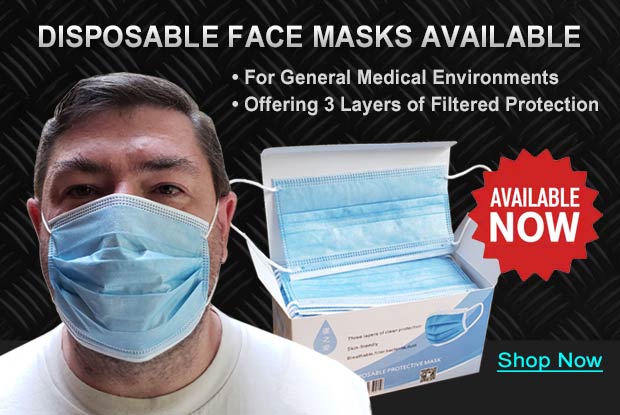Please choose a body region on the right for you to pin point the problem area of your body.

Shop by Condition

Shop by Brand
We’ve been living with the new coronavirus for over a year, and COVID-19 is still spreading, even as the vaccine is here. While we all are reminded to wear a mask, social distance, and stay up to date with your local state vaccination program, as the pandemic wears on, it’s understandable that some people are getting tired of taking coronavirus precautions.
Psychologist Carisa Parrish provides tips you can use to keep up these effective practices, avoid COVID-19 “safety fatigue” or “burnout,” and protect yourself, your family, and others from COVID-19.

Before 2020, the general population was not wearing face masks in public, maintaining physical distancing or washing their hands frequently. Now health experts are recommending these precautions to everyone to prevent the spread of the SARS-CoV-2 coronavirus, which causes COVID-19. And keeping up with it all can be overwhelming.
“Trying to adhere to anything extra is always a challenge,” says Parrish. “You can add extra steps to your routine for a few days, but sustained behavior change is hard. Especially when no one around you is sick, and you just don’t feel like wearing a mask or saying no to things you like to do. But the fact is, the precautions work.”
Dealing With Customers Who Won't Follow Covid-19 Safety Rules
It can feel strange to reorganize your life around a risk that doesn’t seem real, Parrish says.
“Right now, most people are still removed from the consequences of getting COVID-19,” Parrish explains. “The risk might not feel real to them if they don’t know anyone who’s sick with COVID-19. And,” she adds, “unfortunately, some people get a bit of a thrill from doing something risky and escaping consequences.”
Make a commitment. Behavior changes can start with having a clear intention and making a promise. Wearing a helmet when you bike ride, stopping at traffic lights, and many other lifesaving habits begin with a decision: You want to do the right thing to keep yourself and others safe, even if that means a slight inconvenience. The same principle can apply to washing hands, maintaining physical distance and wearing a mask in public.
Stay flexible as recommendations change. New scientific insights about the virus that causes COVID-19 change experts’ recommendations day by day, which causes confusion. You might be asking yourself: Do I still need to disinfect my groceries? Do I need to wear a mask in my car? Is my child safe playing in our yard?
It’s hard — but important — to keep up. “Sticking with reliable, trustworthy information is essential,” says Parrish. “New facts are emerging as we learn more and more about this virus. In the meantime, it makes sense to use the understanding we have.”
Practice precautions until they’re second nature. “The key is repeating that new step until it becomes a habit,” Parrish says. “When you first start flossing or putting your child in a safety seat, it might seem like a chore, even though you know it’s the right thing to do.
“So when it comes to COVID-19 protection, you just commit to it, and then over time, you find you’re putting your mask on or washing your hands without thinking.” Kids, in particular, she notes, thrive with routine and structure.
Keep necessary supplies handy. She also recommends making sure it’s easy to find a mask — and use it — when you need it. “If I can’t find one, it’s an extra step to have to go looking, so to reduce barriers to wearing one, I have several masks and keep them in various places,” she says.
The same idea can apply to hand hygiene. Keeping small bottles of hand sanitizer (with at least 60% alcohol) in several spots can encourage frequent use.
Use stories to understand risks and consequences. For a lot of people, getting sick with COVID-19 is an abstract idea, something that happens to other people in different parts of the country. But the reality is that the coronavirus can affect anyone. “Read a story about someone who’s gone through COVID-19 so it becomes personal to you,” Parrish recommends.
Give kids some choices. When encouraging her kids to wear masks, Parrish says she let her own children customize them. “As more of a variety in patterns became available, I let them pick colors and fabrics they liked.”
Kids can also choose their favorite scent of hand sanitizer or a fun virtual game to enjoy remotely with their friends.
Involve children in keeping families consistent. Parrish says that she lets her children have a voice in making sure the family maintains safety precautions. “I told them they are allowed to remind me if I ever forget my seatbelt,” she says. “Giving them that level of involvement helps keep them engaged in safer practices.”
Parents can give kids permission to remind other family members to maintain physical distance, wear a mask and keep their hands clean.
How to Help Your Child Adapt to Wearing a Mask
The most important thing is not to give up. The coronavirus pandemic isn’t going away anytime soon. Preventive practices are needed until there’s a treatment or vaccine, which could be months away.
Adapting to life with the coronavirus is possible, says Parrish. “Years ago, no one was concerned about secondhand smoke. We didn’t have car seats for children and didn’t put babies on their backs to sleep.
“Accepting this new reality and staying committed to good habits can prevent COVID-19.”
| |
|---|
 Procedural Mask Fasks with Earloops |
 Purell Instant Hand Sanitizer |
| |
|---|
 HR Hand Sanitizer 3 gm Portable Packets |
 PDI Sani-Cloth Bleach Wipe |
 Drive Medical Pulse Oximeter - Fingertip |
| Stay Connected! | |
|
|
|
Related Articles
For more information about the coronavirus, please visit the NYS Department of Health ( www.health.ny.gov ) and the Centers for Disease Control ( www.cdc.gov ) websites.
Get $10 off your next order when you sign up to receive our email newsletter.*
Simply enter your email address below!
*Minimum order value of $100. Valid email address to qualify.







